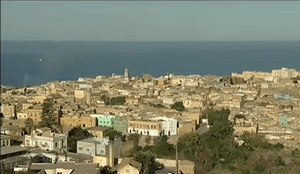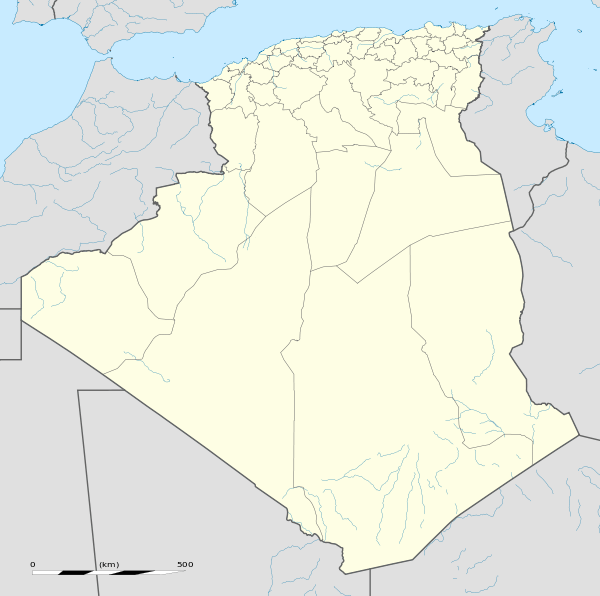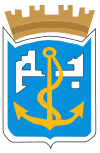Mostaganem
Coordinates: 35°56′N 0°05′E / 35.933°N 0.083°E
| Mostaganem Mustɣanem مستغانم | ||
|---|---|---|
| city | ||
 | ||
| ||
 | ||
 Mostaganem | ||
| Coordinates: DZ 35°56′N 0°5′E / 35.933°N 0.083°E | ||
| Country |
| |
| Province | Mostaganem Province | |
| District | Mostaganem District | |
| Area | ||
| • Total | 50 km2 (20 sq mi) | |
| Elevation | 104 m (341 ft) | |
| Population (2014 census) | ||
| • Total | 245,330 | |
| • Density | 4,900/km2 (13,000/sq mi) | |
| Time zone | CET (UTC+1) | |
| Postal code | 27000 | |
Mostaganem (Berber: Mustɣanem; Arabic: مستغانم) is a port city in and capital of Mostaganem province, in the northwest of Algeria. The city, founded in the 11th century lies on the Gulf of Arzew, Mediterranean Sea and is 72 km ENE of Oran. It has 245,330 inhabitants as of the 2014 census.[1]
The city was founded in the 11th century as Murustage but has origins going back to Punic and Roman times. In 1516 it was captured by the Ottoman admiral Barbarossa and became a centre for Mediterranean sea corsairs, as well as a commercial port. By 1700 it had come under Ottoman rule and in 1833 the city was taken by France and a garrison established. Algeria became independent in 1962.
History
Mostaganem corresponds to the ancient Punic port of Murustaga. After becoming part of the Roman Empire, it was, according to some sources, officially renamed Cartennae under the emperor Gallienus (253–268).[2] However, according to more weighty sources, Cartennae (or Cartenna or Cartennas) corresponds instead to modern Ténès, 50 km to the east.[3][4] In any case, Murustaga is the name by which the town was known when it became a Christian bishopric, and by which it is referred to in the Catholic Church's list of episcopal sees.[5] It also underlies the modern name of Mostaganem.
The town was conquered by the Almoravid dynasty, and reached its high point of power under Yusuf ibn Tashfin (c. 1061-1106). Mostaganem was later ruled by the Zayyanid dynasty of Tlemcen and the Marinid dynasty of Fes. In the 16th century, the town resisted a Spanish invasion and came under the power of the Ottoman Hayreddin Barbarossa.[2]
Present situation
The city is divided in two by a ravine of the river Aïn Sefra, with the modern town to southwest, and the old Muslim city, Tidgit, to the northeast.
In 2010 a tunnel moving under the city towards the city centre is expected to change circulation by a lot. Also, new buildings, some modern and some in colonial style are being added to this growing city. The new autoroute from the capital Algiers towards Oran will make it easier also to access Mostaganem by road from the capital, as Mostaganem has no public airport. The road connecting Oran (around 80 km from Mostaganem to the west) will remain the same, a crowded 2 lane in each direction highway.
The port of Mostaganem is being used for unloading of all sorts of cargo, ranging from provisions to cars and pipelines. As in most ports of Algeria, it is not allowed to sailors to exit the port and visit the city. The port is being shared by large transport vessels and fishing boats alike. A new, smaller port for fishing boats has been constructed, but is currently not used.
Notable people
Mostaganem has given birth to illustrious figures such as playwright Ould Abderrahmane Abdelkader AKA Kaki, cinema director Mohamed Chouikh, historians such as Moulay Belhamissi, and lyricists such as Kadda Medjeded. A major centre of popular and amateur theater, it is home to important specialists of Andalusian classical music (Moulay Benkrizi), Chaabi (Maazouz Bouadjadj, Habib Bettahar), masters of traditional Bedouin music (Sheikh Hamada, Sheikh Djilali Ain Tedeles) and poets such as Sheikh Abdelkader Bentobdji and Sidi Lakhdar Benkhelouf who are authors of well-known qacidates of Malhun poetry bequeathed as much to the Chaabi legacy as to Bedouins such as Abdelkader ya Boualem. Muhammad ibn Ali as-Senussi originated from near Mostaganem.
Furthermore, one of the most notable religious figures of the 20th century was also born and later buried in Mostaganem, the Great Sufi Master, Ahmad al-Alawi, who played a major role in spreading the Shadhili Darqawi tariqa (spiritual order) across the globe, such that this order is now considered one of the world's largest and most influential Sufi paths. Many modern Muslims consider al-Alawi to be one of the "revivers" of Islam in the 20th century due to his role in spreading the religion, and even influencing the West, including opening the first mosque in Paris. Al-Alawi's tomb is now a popular visitation sight in Mostaganem.
- Louis Franchet d'Espèrey, French general, was born in Mostaganem in 1856.
- Alain-Julien Rudefoucauld, French writer and playwright was born in Mostaganem in 1950.
See also
References
- ↑
- 1 2 Murustaga-Mostaganem
- ↑ J. D. Fage, Roland Anthony Oliver (editors), The Cambridge History of Africa, Vol. 2 (Cambridge University Press 1978 ISBN 978-0-52121592-3), p. 118
- ↑ François Decret, Early Christianity in North Africa (James Clarke & Co. 2014 ISBN 978-0-22790308-7), p. 84
- ↑ Annuario Pontificio 2013 (Libreria Editrice Vaticana, 2013, ISBN 978-88-209-9070-1), p. 935
External links
| Wikimedia Commons has media related to Mostaganem. |
- Mostaganem dz by Mohammed Abbassa
- History and old postcards of Algeria
- Annals of Heritage (Journal of the University)
- Mostaganem pictures and many things by S. Benhenda
- Mostaganem Its History, Photograph, Current events, Culture, Geography

